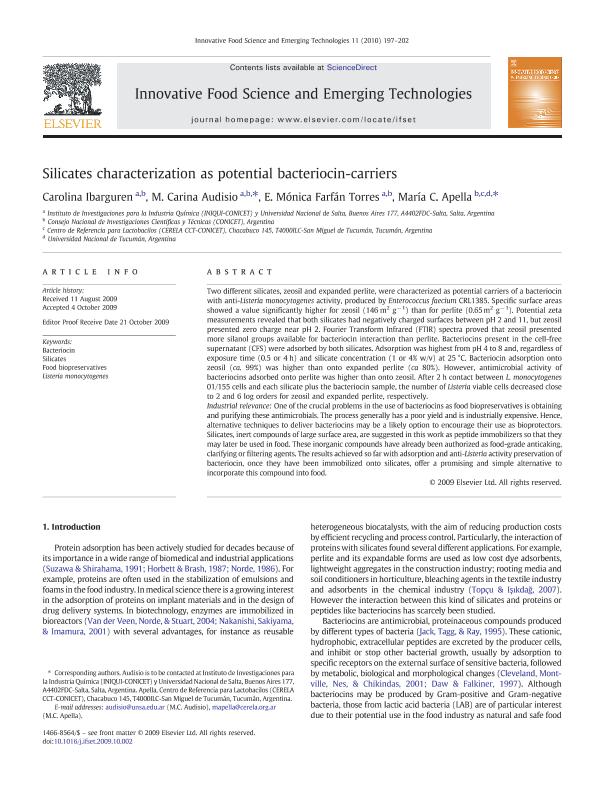Mostrar el registro sencillo del ítem
dc.contributor.author
Ibarguren, Carolina

dc.contributor.author
Audisio, Marcela Carina

dc.contributor.author
Farfan Torres, Elsa Monica

dc.contributor.author
Apella, Maria Cristina

dc.date.available
2019-06-13T19:18:24Z
dc.date.issued
2010-01
dc.identifier.citation
Ibarguren, Carolina; Audisio, Marcela Carina; Farfan Torres, Elsa Monica; Apella, Maria Cristina; Silicates characterization as potential bacteriocin-carriers; Elsevier; Innovative Food Science & Emerging Technologies; 11; 1; 1-2010; 197-202
dc.identifier.issn
1466-8564
dc.identifier.uri
http://hdl.handle.net/11336/78258
dc.description.abstract
Two different silicates, zeosil and expanded perlite, were characterized as potential carriers of a bacteriocin with anti-Listeria monocytogenes activity, produced by Enterococcus faecium CRL1385. Specific surface areas showed a value significantly higher for zeosil (146 m2 g- 1) than for perlite (0.65 m2 g- 1). Potential zeta measurements revealed that both silicates had negatively charged surfaces between pH 2 and 11, but zeosil presented zero charge near pH 2. Fourier Transform Infrared (FTIR) spectra proved that zeosil presented more silanol groups available for bacteriocin interaction than perlite. Bacteriocins present in the cell-free supernatant (CFS) were adsorbed by both silicates. Adsorption was highest from pH 4 to 8 and, regardless of exposure time (0.5 or 4 h) and silicate concentration (1 or 4% w/v) at 25 °C. Bacteriocin adsorption onto zeosil (ca. 99%) was higher than onto expanded perlite (ca 80%). However, antimicrobial activity of bacteriocins adsorbed onto perlite was higher than onto zeosil. After 2 h contact between L. monocytogenes 01/155 cells and each silicate plus the bacteriocin sample, the number of Listeria viable cells decreased close to 2 and 6 log orders for zeosil and expanded perlite, respectively. Industrial relevance: One of the crucial problems in the use of bacteriocins as food biopreservatives is obtaining and purifying these antimicrobials. The process generally has a poor yield and is industrially expensive. Hence, alternative techniques to deliver bacteriocins may be a likely option to encourage their use as bioprotectors. Silicates, inert compounds of large surface area, are suggested in this work as peptide immobilizers so that they may later be used in food. These inorganic compounds have already been authorized as food-grade anticaking, clarifying or filtering agents. The results achieved so far with adsorption and anti-Listeria activity preservation of bacteriocin, once they have been immobilized onto silicates, offer a promising and simple alternative to incorporate this compound into food.
dc.format
application/pdf
dc.language.iso
eng
dc.publisher
Elsevier

dc.rights
info:eu-repo/semantics/openAccess
dc.rights.uri
https://creativecommons.org/licenses/by-nc-sa/2.5/ar/
dc.subject
Bacteriocin
dc.subject
Food Biopreservatives
dc.subject
Listeria Monocytogenes
dc.subject
Silicates
dc.subject.classification
Biotecnología Industrial

dc.subject.classification
Biotecnología Industrial

dc.subject.classification
INGENIERÍAS Y TECNOLOGÍAS

dc.title
Silicates characterization as potential bacteriocin-carriers
dc.type
info:eu-repo/semantics/article
dc.type
info:ar-repo/semantics/artículo
dc.type
info:eu-repo/semantics/publishedVersion
dc.date.updated
2019-06-03T14:30:20Z
dc.identifier.eissn
1878-5522
dc.journal.volume
11
dc.journal.number
1
dc.journal.pagination
197-202
dc.journal.pais
Países Bajos

dc.journal.ciudad
Amsterdam
dc.description.fil
Fil: Ibarguren, Carolina. Consejo Nacional de Investigaciones Científicas y Técnicas. Centro Científico Tecnológico Conicet - Salta. Instituto de Investigaciones para la Industria Química. Universidad Nacional de Salta. Facultad de Ingeniería. Instituto de Investigaciones para la Industria Química; Argentina
dc.description.fil
Fil: Audisio, Marcela Carina. Consejo Nacional de Investigaciones Científicas y Técnicas. Centro Científico Tecnológico Conicet - Salta. Instituto de Investigaciones para la Industria Química. Universidad Nacional de Salta. Facultad de Ingeniería. Instituto de Investigaciones para la Industria Química; Argentina
dc.description.fil
Fil: Farfan Torres, Elsa Monica. Consejo Nacional de Investigaciones Científicas y Técnicas. Centro Científico Tecnológico Conicet - Salta. Instituto de Investigaciones para la Industria Química. Universidad Nacional de Salta. Facultad de Ingeniería. Instituto de Investigaciones para la Industria Química; Argentina
dc.description.fil
Fil: Apella, Maria Cristina. Consejo Nacional de Investigaciones Científicas y Técnicas. Centro Científico Tecnológico Conicet - Tucumán. Centro de Referencia para Lactobacilos; Argentina. Universidad Nacional de Tucumán. Facultad de Ciencias Naturales e Instituto Miguel Lillo; Argentina
dc.journal.title
Innovative Food Science & Emerging Technologies

dc.relation.alternativeid
info:eu-repo/semantics/altIdentifier/doi/https://doi.org/10.1016/j.ifset.2009.10.002
dc.relation.alternativeid
info:eu-repo/semantics/altIdentifier/url/https://www.sciencedirect.com/science/article/pii/S1466856409001179
Archivos asociados
